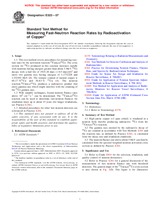We need your consent to use the individual data so that you can see information about your interests, among other things. Click "OK" to give your consent.
ASTM E523-07
Standard Test Method for Measuring Fast-Neutron Reaction Rates by Radioactivation of Copper
STANDARD published on 1.6.2007
The information about the standard:
Designation standards: ASTM E523-07
Note: WITHDRAWN
Publication date standards: 1.6.2007
SKU: NS-47088
The number of pages: 3
Approximate weight : 9 g (0.02 lbs)
Country: American technical standard
Category: Technical standards ASTM
Annotation of standard text ASTM E523-07 :
Keywords:
activation, activation reaction, copper, cross section, dosimetry, fast-neutron monitor, neutron metrology, pressure vessel surveillance, reaction rate, ICS Number Code 17.240 (Radiation measurements), 27.120.30 (Fissile materials and nuclear fuel technology)
Additional information
| Significance and Use | ||||||||||||||
|
Refer to Guide E 844 for the selection, irradiation, and quality control of neutron dosimeters. Refer to Practice E 261 for a general discussion of the measurement of fast neutron fluence rate with threshold detectors. The general shape of the 63Cu(n,α)60Co cross section is also shown in Fig. 1(3). This figure is for illustrative purposes only to indicate the range of response of the 63Cu(n,α) reaction. Refer to Guide E 1018 for descriptions of recommended tabulated dosimetry cross sections. Note 1—The cross section appropriate for use under this standard is ENBDF/B-VI release 8 library since it contains a covariance matrix. The ENDF/B-VII library has been released, but it does not contain a covariance matrix for this reaction. For dosimetry applications, an uncertainty metric expressed as a covariance matrix is required. See Guide E 1018. The chief advantages of copper for measuring fast-neutron fluence rate are that it has good strength, is easily fabricated, has excellent corrosion resistance, has a melting temperature of 1083°C, and can be obtained pure. The half-life of 60Co is long and its decay scheme is simple and well known. The disadvantages of copper for measuring fast neutron fluence rate are the high reaction apparent threshold of 5 MeV, the possible interference from cobalt impurity (>1 μg/g), the reported possible thermal component of the (n,α) reaction, and the possibly significant cross sections for thermal neutrons for 63Cu and 60Co (that is 4.5 and 2.0 barns, respectively),(4) which will require burnout corrections at high fluences.
|
||||||||||||||
| 1. Scope | ||||||||||||||
|
1.1 This test method covers procedures for measuring reaction rates by the activation reaction 63Cu(n,)60Co. The cross section for 60Co produced in this reaction increases rapidly with neutrons having energies greater than about 5 MeV. 60Co decays with a half-life of 1925.28 days (0.5 days)() and emits two gamma rays having energies of 1.1732228 and 1.332492 MeV (). The isotopic content of natural copper is 69.17 % 63Cu and 30.83 % 65Cu(). The neutron reaction, 63Cu(n,)64Cu, produces a radioactive product that emits gamma rays which might interfere with the counting of the 60Co gamma rays. 1.2 With suitable techniques, fission-neutron fluence rates above 109 cm2s1 can be determined. The 63Cu(n,)60Co reaction can be used to determine fast-neutron fluences for irradiation times up to about 15 years (for longer irradiations, see Practice E 261). 1.3 Detailed procedures for other fast-neutron detectors are referenced in Practice E 261. This standard does not purport to address all of the safety concerns, if any, associated with its use. It is the responsibility of the user of this standard to establish appropriate safety and health practices and determine the applicability of regulatory limitations prior to use. |
||||||||||||||
| 2. Referenced Documents | ||||||||||||||
|



 Cookies
Cookies
